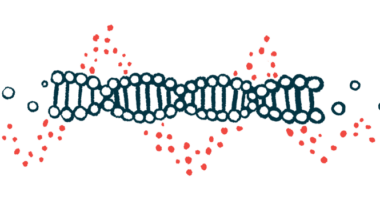Researchers Shed Light on Molecular Mechanisms Behind Cushing’s Pituitary Tumors

The levels of a small number of microRNAs (miRNAs) — small RNA molecules that regulate the activity of other genes — are significantly different between tumors in the brain’s pituitary gland that cause Cushing’s disease and those not associated with the disease, a study shows.
Notably, hsa-miR-124-3p, an miRNA present at higher levels in Cushing’s tumors, was found to suppress cortisol signaling, which may explain the excess production of adrenocorticotropic hormone (ACTH) that results in Cushing’s disease.
These findings shed light on the underlying molecular mechanisms of Cushing’s-causing pituitary tumors and may help identify new therapeutic targets and approaches, the researchers said.
The study, “Difference in miRNA Expression in Functioning and Silent Corticotroph Pituitary Adenomas Indicates the Role of miRNA in the Regulation of Corticosteroid Receptors,” was published in the International Journal of Molecular Sciences.
Cushing’s disease is commonly caused by benign pituitary gland tumors, called corticotroph pituitary adenomas, that overly produce ACTH, a hormone that stimulates cortisol production by the adrenal glands, which sit atop the kidneys.
Cortisol is a glucocorticoid — a steroid hormone produced by the adrenal glands — that controls several bodily processes. Excess cortisol leads to Cushing’s wide variety of physical, hormonal, and psychological symptoms.
A significant proportion of pituitary adenomas — while more aggressive and resistant to treatment — do not produce higher-than-normal levels of ACTH and do not lead to Cushing’s symptoms. These tumors are classified as subclinical or silent corticotroph adenomas.
“The mechanism underlying the difference in secretory activity of [Cushing’s disease]-causing and subclinical tumors is unclear,” the researchers wrote.
The few studies focusing on these differences show the two types of tumors have a very similar gene activity profile, but there are some differences in the activity of certain genes involved in the regulation of proopiomelanocortin (POMC), the precursor of ACTH, and pituitary maturation.
Now, a team of researchers in Poland has analyzed the miRNA profile of 28 Cushing’s-causing pituitary tumors and 20 subclinical tumors to assess whether there were differences that could explain the abnormal ACTH secretory activity in those causing the disease.
miRNAs are small RNA molecules that target a particular gene’s messenger RNA (mRNA) — the intermediate molecule derived from DNA that is used as a template for protein production — to prevent the production of that protein.
A single miRNA can regulate several mRNAs, and a single mRNA can be regulated by multiple miRNAs.
Results showed that of the more than 1,900 miRNAs analyzed, 19 (less than 1%) were differently produced between the two types of tumors. Notably, Cushing’s-causing tumors had significantly higher levels of 16 miRNAs and significantly lower levels of three miRNAs relative to subclinical tumors.
This low number of miRNAs that show differences between these tumors resembles the results from previous studies showing that only 34 genes had different activity levels.
“Generally, both observations indicate a very common molecular profile of corticotroph adenomas, regardless of the functional status,” the researchers wrote.
Also, the levels of 13 of these miRNAs were significantly associated with ACTH or cortisol levels, “further supporting the role of these miRNAs in secretory activity of corticotroph adenomas,” they wrote.
Additional analysis revealed that most potential targets of these miRNAs were involved in steroid hormone activity and steroid receptor functioning. Two of these targets were the NR3C1 and NR3C2 genes.
NR3C1 provides instructions to produce the glucocorticoid receptor protein and is a known target of a miRNA called hsa-miR-124-3p. NR3C2 codes for a receptor protein of both glucocorticoids and mineralocorticoids, a class of corticosteroids, and is suppressed by hsa-miR-135-5p.
Both receptor proteins are located at the surface of cells, including those of the pituitary gland, and they are activated by glucocorticoids, including cortisol. This binding results in a cascade of processes that regulates the activity of several genes, which in the pituitary gland include those regulating the production of POMC, and subsequently ACTH.
Cushing’s-causing tumors showed higher levels of both hsa-miR-124-3p and hsa-miR-135-5p and reduced activity of their target genes, NR3C1 and NR3C2.
Further analyses in lab-grown mouse pituitary tumor cells revealed that miR-124-3p directly binds to the NR3C1 gene and that increasing miR-124-3p levels reduced NR3C1 activity and the levels of the glucocorticoid receptor.
Given that this cellular model of corticotroph adenoma — the only available to date — does not produce the mineralocorticoid receptor, “we can only hypothesize that miRNA-mediated silencing of NR3C2 may have the similar effect … as silencing of NR3C1,” the researchers wrote.
These data suggest that high levels of hsa-miR-124-3p and hsa-miR-135-5p may lower the number of glucocorticoid receptors in pituitary gland cells, therefore reducing cortisol signaling and its suppressive effects on ACTH production. The result will be excess ACTH production that increases cortisol levels and leads to Cushing’s symptoms.
This agrees with previous studies showing that NR3C1 mutations affects pituitary tumors’ secretory activity and result in their resistance to steroids.
Still, the regulation of glucocorticoid receptors by miRNAs is likely just “one of the mechanisms in the regulation of corticotrophs’ secretory activity,” the team wrote.
These findings “may have important therapeutical implications in [Cushing’s disease] patients,” and further studies are needed to assess the role of glucocorticoid receptor abnormalities in response to glucocorticoid receptor-targeting therapies such as Korlym (mifepristone), they added.
The role of the other 17 differently produced miRNAs remains unclear. Five of them, all found in excess in Cushing’s-causing tumors, were previously shown to reduce the levels of FOXO1, a protein involved in maturation of pituitary cells and that potentially suppress POMC production.
As such, “the exact role of miRNAs in possible FOXO1-related regulation of secretory activity of corticotroph cells requires further functional investigation,” the team wrote.







